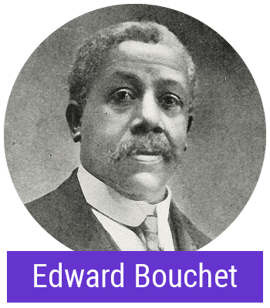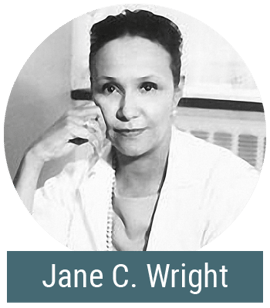Diversity, equity, and inclusion are important to us at BenchSci and as a part of our DEI journey, we are committed to learning about, celebrating, and amplifying the voices and accomplishments of people from diverse backgrounds. In honor of Black History Month, we are taking this opportunity to celebrate some of the significant contributions Black scientists have made to advancing STEM fields. Here, we showcase ten influential scientists and their extraordinary achievements.

Jewel Plummer Cobb (b. 1924, d. 2017) was a biologist and cancer researcher best known for her contributions to our understanding of melanoma treatment. Her work investigated the relationship between melanin and skin damage and the effects of hormones, ultraviolet light, and chemotherapy agents on cell division, which led to her discovery of methotrexate as an effective treatment for certain skin and lung cancers, as well as childhood leukemia. She was elected to the Institute of Medicine in the National Academy of Sciences in 1974 and was a member of the National Science Board from 1974 to 1980.
In addition to her scientific contributions, Cobb dedicated herself to supporting the development of Black institutions. At one point, she served as vice president of the 21st Century Foundation, a nonprofit that works to advance the Black community. She advocated for increased representation of women and students of color in universities and created support programs for graduate students.
Read more about Jewel Plummer Cobb.
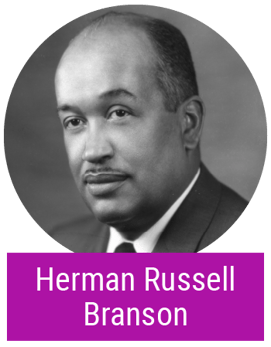
Herman Russell Branson (b. 1914, d. 1995) was a physicist and chemist known for his research on the alpha helix protein structure. He received his B.S. from Virginia State College in 1936, followed by a Ph.D. in physics from the University of Cincinnati in 1939. Branson then joined Howard University, where he worked for 27 years, making significant contributions to our understanding of proteins and their role in diseases such as sickle cell anemia. He also spent time researching protein structure at the California Institute of Technology in 1948. Branson later served as the president of two colleges and advocated for increased federal funding for higher education.
Read more about Herman Russell Branson.
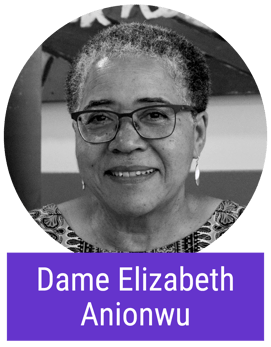
Dame Elizabeth Nneka Anionwu (b. 1947) is a British nurse, health care administrator, lecturer, and professor of Irish and Nigerian heritage. She is regarded as a key figure in the development of nursing care for those with sickle cell anemia and thalassemia.
Anionwu began her career at age 16 as an NHS school nurse assistant in Wolverhampton before traveling to the United States to study counseling for sickle-cell and thalassemia. She has made numerous contributions to the field of sickle-cell and thalassemia counseling. In 1979, she helped to establish the first nurse-led center for sickle cell and thalassemia screening and counseling in London, UK, which helped establish the practice of screening babies nationwide. She later served as Dean of the School of Adult Nursing and Professor of Nursing at the University of London. There, Anionwu established the Mary Seacole Centre for Nursing Practice in 1999, which she headed until her retirement in 2007.
She was awarded Nigeria's Order of Merit in 2001, named Dame Commander of the Order of the British Empire in 2003, and has been recognized with a lifetime achievement award from the Sickle Cell Society.
Read more about Dame Elizabeth Nneka Anionwu.
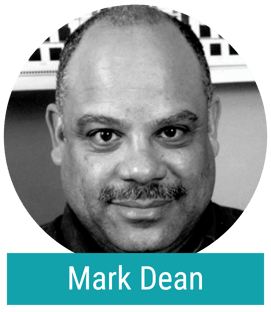
Mark Dean (b. 1957) is a computer engineer and inventor recognized as one of the most important contributors to the development of the personal computer. After earning his B.S. in electrical engineering from the University of Tennessee, Dean joined IBM as a chief engineer. While at IBM, he played a key role in developing the first PC, with three of the nine original patents registered in his name. His work contributed to such innovations as color monitors, the Industry Standard Architecture bus (which makes it possible to connect external devices such as printers), and the first gigahertz chip.
Dean continued his studies, earning an M.S. from Florida Atlantic University before completing his Ph.D. in electrical engineering at Stanford. He was made an IBM Fellow, the company's highest honor, in 1995 and was appointed Vice President in 1997. He holds over 40 patents and has been inducted into the National Inventors Hall of Fame. He was also elected into the National Academy of Engineering in 2001.
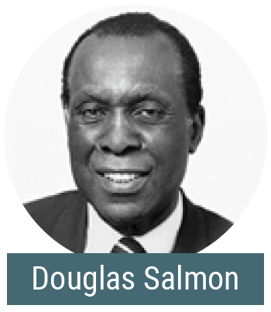
Douglas Salmon (b. 1923, d. 2005) was Canada's first Black surgeon. He earned an honors B.A. in physiology and biochemistry from the University of Toronto in 1951 before attending its School of Medicine. Despite being one of only four Black students in his class, he excelled in his studies and was eventually elected class president. After graduating from medical school, he interned at Toronto Western Hospital.
In 1967, he joined the Scarborough Centenary Hospital's general surgical staff, eventually rising to become the first Black person in Canada to hold such positions as President of Medical Staff and Chief of General Surgery. In recognition of his accomplishments, Salmon was made a fellow of the Royal College of Surgeons and the American College of Surgeons. He also received the Canadian Black Achievement Award in Medicine.
In addition to his medical contributions, Salmon is known for his work fighting for Black rights as a vocal protest leader and part of the Race Discrimination Committee. Today, his family funds the Dr. J. Douglas Salmon Award for Black Medical Students in his honor to help reduce barriers to education impacting Black students.
Read more about Douglas Salmon.
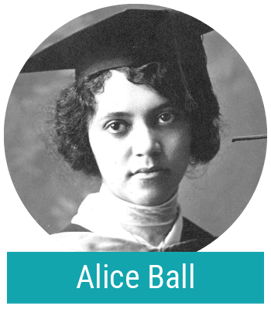
Alice Ball (b. 1892, d. 1916) was a chemist most notable for developing the first successful leprosy treatment. She earned undergraduate degrees in pharmaceutical chemistry and pharmacy before becoming the first African-American and the first woman to receive a Master's degree in chemistry from the College of Hawaii (now the University of Hawaii).
Following her graduation, she was offered a teaching and research position at the institution and became its first female chemistry instructor. Ball's injectible leprosy treatment, created using oil from the chaulmoogra tree, was successfully administered to thousands of people infected with leprosy until sulfone drugs were introduced in the late 1940s. Credit for her discovery was falsely claimed by Dr. Arthur Dean, the college president, however, she’s recently received the recognition she deserves from the scientific community.
George Washington Carver (b. ~1864, d. 1943) was an agricultural scientist and the first African-American to receive a Bachelor of Science degree, which he followed by earning his Master's in agriculture. He is perhaps best known for developing crop rotation practice, which allowed farmers to increase their cotton yields significantly. Carver also invented hundreds of products (both food and non-food) derived from peanuts, sweet potatoes, and soybeans as a way to utilize the alternative (non-cotton) crops needed for crop rotation to work.
In the later years of his life, he spent time promoting racial harmony in the southern United States and nutrition in India with Mahatma Gandhi. Following his death, he was honored with the George Washington Carver National Monument, the first national monument dedicated to someone who did not serve as a U.S. president.
Read more about George Washington Carver.
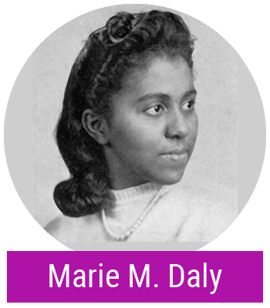
Marie Maynard Daly (b. 1921, d. 2003) was a biochemist notable for groundbreaking research in several areas of biology. She completed her Bachelor's degree in chemistry at Queens College and her Master's at New York University before earning her Ph.D. from Columbia University, making her the first African-American to do so.
Daly’s research on histones is considered fundamental, and she was the first to determine the relationship between cholesterol and hypertension, advancing our understanding of how heart attacks occur. James Watson cited her work with proteins as a direct contributor to his Nobel Prize-winning discovery of the double-helix structure of DNA. Daly was also a dedicated teacher who was passionate about increasing minority student enrollment in medical schools, establishing a scholarship fund for African-American science students at Queens College in 1998.
Read more about Marie M. Daly.
Edward Bouchet (b. 1852, d. 1918) was a physicist and educator. In 1876, he made history by earning his Ph.D. in physics at Yale, making him the first African-American to graduate from the prestigious school and the first African-American and sixth person ever to earn a Ph.D. in physics from an American university.
Despite his brilliance, Bouchet was unable to secure a teaching position at a college or university due to racial discrimination, so he took an offer to teach at the Institute for Colored Youth in Philidelphia. He worked there for 26 years until he lost his job in 1902 when the school gave up academic education in favor of industrial training, which many believed to be more suited to African-Americans. Bouchet is remembered today by the Edward A. Bouchet Award (given by the American Physical Society for outstanding contributions to physics) and the Edward Bouchet Abdus Salam Institute (founded in 1988 by Nobel Laureate Professor Abdus Salam).
Read more about Edward Bouchet.
Jane Cook Wright (b. 1919, d. 2013) was a surgeon and cancer researcher, best known for her significant contributions to chemotherapy research. After graduating with honors from New York Medical College in 1945, she interned as an assistant of internal medicine at Bellevue Hospital and then completed her residency at Harlem Hospital.
In 1949, she went to work with her father, Dr. Louis Wright, then the director of the Cancer Research Foundation at Harlem Hospital. Together they began researching new chemicals as potential treatments for leukemias and lymphatic cancer, seeking ways to make chemotherapy more accessible. While there, Wright developed a more effective technique for testing potential cancer drugs using human tissue cultures instead of lab mice. She is also credited with identifying methotrexate, a fundamental chemotherapy drug, as an effective cancer treatment.
Wright's career spanned 40 years, during which time she published over 100 papers on chemotherapy. She served on several councils and advisory boards and received many awards, including an honorary Doctor of Medical Science degree from the Women's Medical College of Pennsylvania.
Read more about Jane Cook Wright.
The hard work and dedication of these and many other Black scientists have helped shape our world, changing how we approach science, technology, engineering, and mathematics.
We believe everyone has a right to pursue and have access to an education and career that inspires them. That's why one of our aspirations with BenchSci Forward is to increase the representation of underrepresented groups in STEM fields by helping them overcome barriers to their success.
Learn more about our commitment to increasing diversity in STEM.

